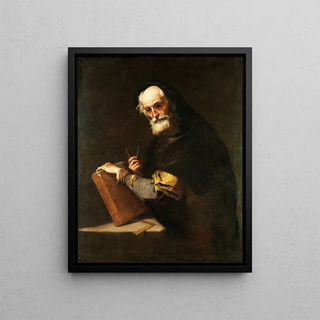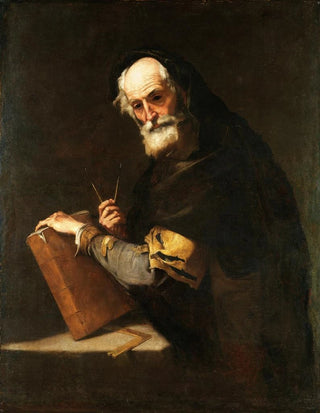Art print | A presumed philosopher to be Archimedes - Jusepe de Ribera


View from behind

Frame (optional)
In the fascinating universe of art history, certain works stand out for their ability to capture the very essence of human thought and emotion. The art print Un philosophe présumé être Archimède - Jusepe de Ribera is a perfect example. This canvas, created in the 17th century, immerses the viewer in a moment of intense reflection, where ancient wisdom seems to dialogue with the concerns of the Baroque era. Ribera, known for his talent in representing light and shadow, succeeds here in bringing to life an iconic character, Archimède, whose intellect and curiosity are palpable. The piece invites deep contemplation and an exploration of themes of knowledge and understanding.
Style and uniqueness of the work
The strength of Ribera's painting lies in its ability to combine impeccable technique with poignant expressiveness. In this work, the treatment of shadows and lights creates a striking contrast, emphasizing the features of Archimède's face and revealing his introspective nature. The carefully chosen colors evoke an atmosphere of gravity and serenity, allowing the viewer to feel the importance of philosophical reflection. The meticulous details of the composition, from the drapery to the objects surrounding the philosopher, demonstrate rare technical mastery. Every element of the canvas seems designed to enrich the message Ribera aims to convey: erudition and wisdom are priceless treasures.
The artist and his influence
Jusepe de Ribera, a master of the Spanish school of the 17th century, knew how to mark his era with his unique style and artistic vision. Born in Játiva, he was influenced by the great masters of Caravaggio, whose techniques of chiaroscuro he integrated into his works. Ribera is not just a painter, but a true chronicler of humanity, interested as much in mythological figures as in portraits of saints and philosophers. His realistic approach and attention to the psychology of characters paved the way for many artists who followed. The impact of his work is still felt today, both in

Matte finish

View from behind

Frame (optional)
In the fascinating universe of art history, certain works stand out for their ability to capture the very essence of human thought and emotion. The art print Un philosophe présumé être Archimède - Jusepe de Ribera is a perfect example. This canvas, created in the 17th century, immerses the viewer in a moment of intense reflection, where ancient wisdom seems to dialogue with the concerns of the Baroque era. Ribera, known for his talent in representing light and shadow, succeeds here in bringing to life an iconic character, Archimède, whose intellect and curiosity are palpable. The piece invites deep contemplation and an exploration of themes of knowledge and understanding.
Style and uniqueness of the work
The strength of Ribera's painting lies in its ability to combine impeccable technique with poignant expressiveness. In this work, the treatment of shadows and lights creates a striking contrast, emphasizing the features of Archimède's face and revealing his introspective nature. The carefully chosen colors evoke an atmosphere of gravity and serenity, allowing the viewer to feel the importance of philosophical reflection. The meticulous details of the composition, from the drapery to the objects surrounding the philosopher, demonstrate rare technical mastery. Every element of the canvas seems designed to enrich the message Ribera aims to convey: erudition and wisdom are priceless treasures.
The artist and his influence
Jusepe de Ribera, a master of the Spanish school of the 17th century, knew how to mark his era with his unique style and artistic vision. Born in Játiva, he was influenced by the great masters of Caravaggio, whose techniques of chiaroscuro he integrated into his works. Ribera is not just a painter, but a true chronicler of humanity, interested as much in mythological figures as in portraits of saints and philosophers. His realistic approach and attention to the psychology of characters paved the way for many artists who followed. The impact of his work is still felt today, both in






